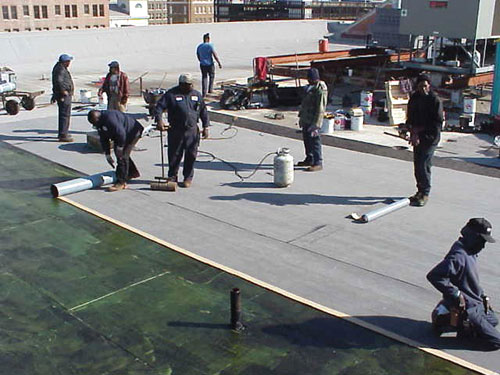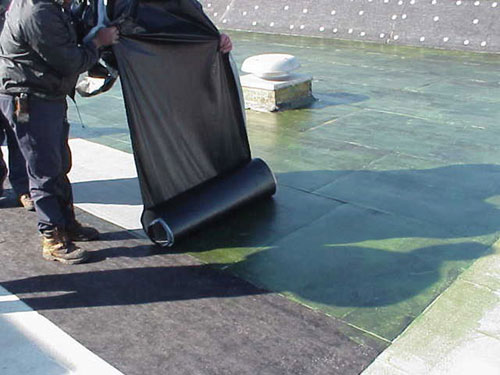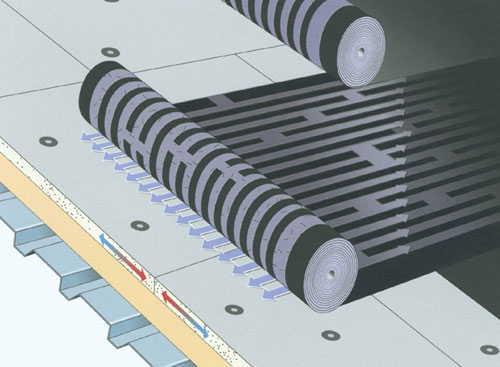"Greater than the tread of armies is an idea whose time has come." —Victor Hugo
Whether we choose to recognize it, change is occurring throughout the United States with asphalt-based roof system installation, specifically dual-membrane SBS-engineered asphalt roof systems.
Many factors have contributed to the momentum for alternative application methods for asphalt-based roof systems, but the most prevalent reason is unwanted fume and/or odor emissions associated with traditional application methods. Such emissions are not harmful, but a growing legion of building owner representatives consider them irritating and desire alternative installation methods.
SBS-engineered asphalt roof system manufacturers are aware of the increasing pressure to develop satisfactory alternative application methods to eliminate methods associated with phrases such as "throwing a roll in hot," "firing up a propane torch" or "squeegeeing out solvent-based cold adhesives." The catalyst for the self-adhered trend is objectionable odor, but many other market forces have coalesced to create a tidal wave of momentum to push manufacturers, roof system designers and roofing contractors into the design and application of self-adhered membranes. Such forces include insurance coverage limitations, building owner/employee sensitivity, laws to support employees' objections to foul-smelling substances or irritants in the workplace, occupant activism, contractor liability, fire-safety issues and favorable marketing opportunities.
A growing number of roofing contractors, consultants, architects and building owners are convinced SBS-engineered asphalt roof systems offer the best value because of years of proven performance. But with these new self-adhered applications, the same people now wonder whether roof systems can be installed reliably without kettles, torches or solvents. And if traditional application methods are eliminated, will the materials in question remain in place for the long-term and perform as those installed with traditional installation methods? The following information will answer these questions.
Background
Installing SBS-engineered low-slope asphalt roof systems traditionally has meant using kettles, torches or solvent-based cold adhesives. Recently, in too many instances, a roof system specifier may prefer using an SBS-engineered asphalt roof system, but he may come across a building owner representative who wants him to use less intrusive and objectionable installation methods.
An issue related to objectionable methods is odor (see "Definitions"). Odors emanating from asphalt-based roof systems can set off a cavalcade of interesting events.
For example, building occupants often complain about smells or fumes. Formerly, a project would continue with some accommodation to mitigate the problem. It now is more common that occupants' objections cannot be overcome and traditional application methods cannot be used. It is far easier for a building owner to request an offending application method be changed than be faced with angry tenets or, if the building is owner-occupied, the accompanying loss of productivity.
Similarly, on many projects, handling and storage issues related to the use of hot asphalt kettles, propane torches or materials high in volatile organic compound emissions disqualify certain application methods from consideration during the design-review process.
There already has been a shift taking place in SBS-engineered asphalt dual-membrane system theory, design and application to account for the changing landscape of installation practices.
Historically, the shift from traditional application methods to a self-adhered approach in low-slope roofing has found its way into some method-critical applications in the United States, albeit slowly, during the past seven years. Method-critical applications are defined by necessary limitations a building owner places on an application method because of obvious, imminent dangers, such as those found at chemical plants or paper mills, or where torches, kettles and cold adhesives are prohibited because of a strict directive by a building owner representative.

Photo courtesy of Soprema Inc., Wadsworth, Ohio.
In 1995, a self-adhered roof system was installed on low-slope roof areas of the Braun Music Center at Stanford University, Stanford, Calif.
In the United States, the broader markets for self-adhered application methods have been on reroofing projects for historical structures typically made of wood or roofing or reroofing projects where logistical aspects present significant cost savings when using self-adhered methods.
The driving forces
Insurance
In North America, dramatic insurance premium increases for roofing contractors whose workers typically use torches or kettles are forcing some contractors to rethink their approaches to roof system construction and de-emphasize the use of torches and kettles. The relative competitiveness of torch-bonded and asphalt-applied SBS roof systems could be negatively affected if insurance underwriters start to perceive risks as inherently dangerous and insurance premiums increase.
It remains unclear what the future holds for insurance premium underwriting in the United States. We know the insurance industry was rocked by the huge Sept. 11, 2001, losses. It is fair to assume there will be upward pressure on premiums in the near future and the insurance industry will continue to look closely at methods and practices to flush out risks.
Contractor liability
In the arena of employer-employee relationships, employees have become increasingly intolerant of any chemicals inadvertently brought into workplaces. Employees' collective intolerance must be evaluated carefully because state and federal laws have created opportunities for employees to easily defend themselves. In so doing, liability accrues for all related parties performing the work, including manufacturers, roofing contractors and architects. Combine this trend of legal protection with an application method that seems threatening or potentially dangerous and all types of warning signs should be apparent to design professionals who advise building owners.
Health professionals say almost everyone potentially is sensitive to smells, odors or fumes resulting from construction that takes place above or adjacent to occupied spaces. Even if an offending application method is legal and relatively nonoffensive, if building occupants negatively react, the consequences from loss of productivity for the building owner can be prohibitively expensive.
These problems go well beyond the application methods of SBS-engineered asphalt roof systems. Single-ply roof systems, such as EPDM, that rely on adhesives for bonding also can create a concern among employees and building owners.
Another liability is a cold-process problem that is apparent when occupied buildings have nonmonolithic roof decks. Without the benefit of warm weather and periods of low atmospheric humidity, the solvent-release process is retarded—low humidity and high temperature are the most important natural forces that expedite the solvent-release process.
Without adequate design measures, such as highly impermeable barriers to stop solvent migration, odors inadvertently may be transmitted into buildings. Air intakes carefully must be assessed from all wind directions to ensure no fumes will be drawn into buildings.
Objectionable odors from solvents can be present for many days and keep people from occupying buildings. If this happens, there typically will be some temporary dislocation costs and health concerns that may require doctors visits. Self-adhesive application methods completely remove objections related to torches and kettles.
Fire safety
Fire safety is a topic that has been examined by many roofing industry professionals and associations. Torch-applied roof systems exhaustively have been studied and torch-safety programs have been developed to ensure safe roofing practices occur at all times.
It is the lapse of one worker or the unsafe work practices of one roofing contractor that creates the dreaded media headline about a building catching fire and incurring significant losses. Although it may be a rare occurrence, particularly with a dual-membrane roof system, fires give torch-application methods a bad reputation and prompt many designers to shy away from recommending such methods.
Urban fire marshals throughout the United States have examined the hazards of kettles, propane containers and torches. In some notable instances in Atlanta; Boston; Chicago; Cleveland New York; and Washington, D.C., administrative guidelines and laws have eliminated rooftop kettles and greatly reduced the maximum size allowed for propane containers. This trend illustrates the tendency of fire marshals to steer away from the unlikely but potentially catastrophic consequences when kettles catch fire, propane explodes or smoldering cants ignite.
The current trend is for regulations to be created to stop work practices that are considered inherently dangerous. Presently, the high-rise marketplace has been most affected. For example, the urethane foam adhesive method of insulation attachment has grown exponentially during the past few years versus hot asphalt-applied attachment because of the almost universal prohibition of rooftop kettles on high-rises.
How they work
Now that you are aware of the factors that brought self-adhered membrane applications to North America, following is how they work.
The typical SBS-modified bitumen polymer used to create an SBS membrane has a relatively high molecular weight and softening point of 270 F (132 C). The polymer blend and compatible base asphalt create an SBS-modified asphalt with low viscosity at most ambient rooftop temperatures. In other words, the typical SBS blend exhibits high cohesive strength with low adhesion force. Therefore, with its characteristic low tack at ambient temperatures, a typical SBS blend is not suitable for self-adhered applications.
To work properly, self-stick membranes must adhere at relatively low temperatures, such as 50 F (10 C). To accomplish this feat, it is necessary to decrease the blend's viscosity or cohesion force. Lower weight polymers must be used to attain this goal. Only then will a self-adhered membrane be soft enough to create good mechanical point-to-point contact with its intended substrate. A membrane must be made pliable enough, or specialized primers must be used.


Photos courtesy of Soprema Inc., Wadsworth, Ohio.
These pictures show a self-adhered application project in Atlanta.
To formulate a self-adhered membrane, a self-adhered polymer, such as styrene isoprene styrene (SIS), must be blended with an asphalt that displays excellent compatibility. At this point, lower molecular weight is achieved, but other ingredients are added to further lower viscosity, control the cohesive force and improve the overall tackiness for the application temperature window. Additives, such as agents and resins that increase tackiness, are required to complete the self-stick formula. With its new, lower viscosity, the self-stick blend exhibits a high tack condition at a relatively low temperature, such as 50 F (10 C), and adheres with high long-term peel strength.
Typically, a midreinforced granulated self-adhered membrane is made by applying an in-process coating of self-stick blend onto a regular SBS blend. The SBS blend is deposited on the reinforcement of choice, and the self-adhered blend is added to the bottom surface when passing through the next asphalt tub in sequence in the manufacturing process. In terms of use, self-stick bitumen is soft and needs to be designed as a thin coating layer (0.02 of an inch to 0.03 of an inch [0.5 mm to 0.7 mm]) to avoid the potential for slippage and keep the finished product from becoming too soft. Self-adhesive side laps also are created in the manufacturing process in the same area. End laps may be created in the field by using special adhesives or in the manufacturing process.
Additionally, midreinforced granulated self-adhered membranes must have enough bitumen to conform to irregular or porous surfaces. If the product could be applied to a perfectly smooth surface, such as a mirror, a less expensive self-stick blend would, in theory, be acceptable. But the demands of typical uneven surfaces require sufficient minimum thickness.
Contrary to typical SBS-engineered asphalt, self-stick blending technology requires a higher level of chemical engineering. Complex chemistry is more costly to produce and demands more manufacturing precision.
During proper manufacturing/engineering practice, these membranes can be applied directly to various substrates and achieve acceptable initial peel strengths to create immediate watertight laps at ambient temperatures. A typical warranty instruction from most manufacturers is 50 F (10 C) and greater. Lap strength then will build to achieve ultimate peel within a few days from any significant heating method, such as air; direct sunlight; or an independent, external source.
The ultimate developed peel strength may achieve 80 percent to 85 percent of a torched lap—our laboratory considers a heat-fused lap to yield the highest peel strength of any method that can be employed to join two SBS-modified bitumen membrane layers.
Design theory
Semi-independent
Several SBS manufacturers in Europe started to market semi-independent attached systems in 1993. This initial foray involved creating a first membrane ply with an alternating or striped ribbed pattern of self-stick blend on the bottom side. The self-stick blend is placed over a receiver facer or specialized receiver board whether it is extruded polystyrene, polyisocyanurate or polyurethane. The top membrane initially was torch-fused.
This last piece of installation practice was mandatory to significantly increase the peel strength of the first membrane ply to the reinforcement by inducing a heavy measure of British thermal units to soften the self-stick blend enough to create stronger bonding with a higher percentage of strong mechanical attachment points. Presently, new and better self-stick blend chemistries are being tested to pro-vide more than sufficient initial peel strength to allow a self-adhered cap membrane ply to be placed on or directly over the first ply, eliminating the use of a torch.
The design theory for using semi-independent attachment versus fully adhered attachment stems from eliminating the divorce board and using one of two designs. First, a membrane is attached directly to a high thermal coefficient insulation even if it is a urethane, as in Europe, or polyisocyanurate used in North America. Because high thermal coefficient insulations exhibit significant movement during temperature changes—whether those changes are driven by thermal shocks or simple diurnal cycles—one design theory dictates there must be something in the design to minimize the danger of material fatigue failure above the board joints during the long-term, such as 30 years.
Some manufacturers have opted to only attach their roof membranes directly to high thermal coefficient insulation with a semi-independent approach knowing the method spreads the load strain when joint displacement occurs. The semi-attached membrane spreads the load strain over a much wider portion of the membrane, reducing the total load any membrane portion ever will receive (see illustration).

Illustration courtesy of Soprema Inc., Wadsworth, Ohio.
This illustration shows a semi-independent attached system over specialized polyisocyanurate.
Mechanically fastened
A second approach that is equally effective at spreading the load strain involves the use of a mechanically fastened base membrane. Once the base membrane is mechanically installed, the top surface of the first ply is conditioned with a specialized primer or light adhesive—1/2 gallon per square (0.2 L per m²) is typical. The second self-adhered ply then is set, and the release film is pulled sideways from below.
Fully adhered
Another system approach is to use specialized divorce or separator boards over high thermal coefficient insulation to greatly reduce joint displacement. Such insulation boards typically are installed with mechanical fastening or foam adhesives or a combination of both. When these boards are used, fatigue concerns are minimized and fully adhered systems are allowed.
The fully adhered approach typically involves spreading a special primer or light adhesive over the specialized divorce board if the ambient air and substrate temperatures have not risen high enough—the substrate typically must be in the 90 F (32 C) range with at least a 70 F (21 C) air temperature to consider applications without priming such substrates. The cap membrane or second ply then is placed with the appropriate end lap and side lap staggering to complete the dual-membrane system.
In the current marketplace, a couple of manufacturers of self-adhered SBS-based dual-membrane roof systems offer a 20-year warranty program. These systems come with track records of up to 10 years. They also have traditional substrates with new generation primers or substrates. The systems being marketed also have building code and agency approvals.
Ratings issues
Fire testing
To meet ASTM E108, "Standard Test Method for Fire Tests of Roof Coverings," or UL 790, "Standard for Tests for Fire Resistance of Roof Covering Materials," fire-retardant chemistry must be used in membrane design to achieve Class A results. Exhaustive trial and error test methodology is necessary to discover the proper mix of fire retardent with a blend that is compatible and provides the same long-term resistance to heat aging and cyclic fatigue. If the correct studies are not undertaken, the self-adhered blend's most important quality—its initial and long-term ability to hold and keep its adhesive bond—could be greatly compromised.
Typically, a Class A fire rating is achieved at lower slopes, such as 1/2-in-12 (2.4 degrees), because the self-adhered blend has a lower softening point (earlier and heavier flow during testing) and typically achieves lower peel strengths to substrates.
In addition, the fire-retardant chemistry only should be added to the SBS blend, not the self-stick blend. Therefore, there is a theoretical, strict limitation on the total amount of inexpensive fire retardant by weight that may be added to an SBS blend or the total blend quality is compromised. Alternatively, more effective and expensive fire-retardant materials typically are used when developing a product with poorer fire-resistant capability. Reinforcements also play a critical role in this regard. The result often is a self-adhered membrane that is more expensive not just because of its blend but because of its fire-retardant chemistry.
Uplift
Self-adhered membranes typically succeed or fail based on their inherent ability to resist peel at the substrate board's juncture when trying to attain resistance. If only one layer of substrate is used, such as a polyisocyanurate with a special facer, peel-away failure will occur earlier than if a second layer were used to reduce insulation joint peel-away pressure. This can be proved by reviewing the 2003 FM Approval Guide.
The uplift limitation stems from differences in ultimate peel strength and elongation capability of the interface of the two membranes once they are joined or when they exert force in unison to the substrate to which they are adhered.
Therefore, manufacturers are cognizant that failure of multi-ply self-adhered roof systems typically will occur at the first membrane/substrate junction. This has led to the development of special facers for polyisocyanurate and special divorce boards to be employed over high thermal coefficient insulation.
Future trends
There is no doubt the concerns raised about traditional application methods with SBS-engineered asphalt roof systems will not disappear. In fact, building owners are increasing pressure on manufacturers and roofing contractors because they still want the inherent benefit of SBS-engineered asphalt roof systems without the concern of application methods, particularly on projects where buildings are occupied. This trend then is coupled with the trend among design professionals who commonly eschew application liability issues.
The traditional application methods will remain intact, especially on new construction projects. However, the marketplace will continue to dictate different, less intrusive application methods over occupied spaces.
Engineered SBS/SIS asphalt blends' naturally high cohesive and adhesive benefits give them a unique place among the roof systems available. The installation and design benefits these systems collectively offer barely have approached their potential market penetration. With improved formulas for weather performance and ultimate bond strength, self-adhered roof systems will offer everything current roof systems offer with one significant difference—peace of mind for building owners.
Charlie Hallenbeck is technical sales manager of Soprema Inc., Wadsworth, Ohio.
Definitions
Fumes—An irritating or disagreeable exhalation of smoke, vapor or gas.
Odor—The property or quality of a thing that stimulates or is perceived by the sense of smell.
Smell—To perceive the scent of (something) by means of the olfactory nerves.
Source: Webster's II New College Dictionary
Installation practice notes
Self-adhered roof systems suffer when unprepared or unacceptable substrates, moisture, contamination, cold temperatures and improper installation techniques occur.
Moisture can be evaporated with a torch, or slight amounts may be burned off with hot asphalt. A self-adhered system must be dry when installed or the membrane will not bond where the moisture exists. Those spots of disbondment can raise the prospect of further adjacent disbondment and the possibility of larger-scale delamination.
Similarly, cleanliness is a must because of direct point-to-point contact interference. Once dirt or foreign particles are trapped between layers of self-adhesive, the particles will impede good adhesion at that exact point or, in the worst case, may cause chronic adhesion and cohesion failure.
In cold weather, a self-stick blend becomes increasingly stiff and possible points of contact are reduced. At a certain temperature and substrate condition, the bond strength is insufficient for a successful bond—air will be trapped by futile attempts of continuous rolling and rerolling.
Warmth, dryness, cleanliness and following manufacturers' instructions regarding installing membranes and releasing film or paper from the self-adhered surfaces will allow for excellent short- and long-term bonding.
COMMENTS
Be the first to comment. Please log in to leave a comment.